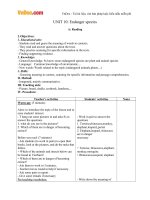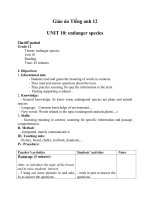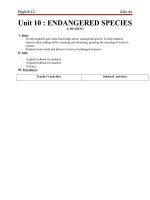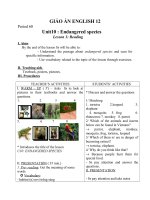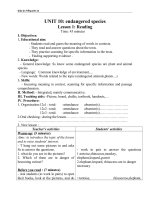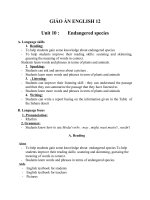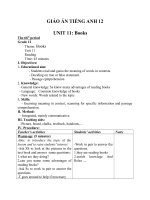Giáo án Tiếng Anh 12 unit 10: Endangered species
Bạn đang xem bản rút gọn của tài liệu. Xem và tải ngay bản đầy đủ của tài liệu tại đây (221.7 KB, 17 trang )
GIÁO ÁN ENGLISH 12
Period 60
Unit10 : Endangered species
Lesson 1: Reading
I. Aims
By the end of the lesson Ss will be able to:
- Understand the passage about endangered species and scan for
specific information.
- Use vocabulary related to the topic of the lesson through exercises.
II. Teaching aids
Textbook, posters, pictures.
III. Procedures
TEACHER’S ACTIVITIES
STUDENTS’ ACTIVITIES
I. WARM – UP ( 5') – Asks Ss to look at
pictures in their textbooks and answer the * Discuss and answer the questions
questions.
1.
2.
3
4
1/ Matching
1. tortoise
2.leopard
3.
elephant
4. mosquito
5. frog
6.
rhinoceros 7. monkey 8. parrot
2/ Which of the animals and inserts
5.
6
7
8
below can be found in Vietnam?
→
parrot,
elephant,
monkey,
mosquito, frog, tortoise, leopard
3/ Which of them is/ are in danger of
becoming extinct?
→ tortoise, elephant.
* Introduces the title of the lesson
4/ Why do you think like that?
U10: ENDANGERED SPECIES
→ Because people hunt them for
special food.
- Ss pay attention and answer the
II. PRESENTATION ( 35 min.)
questions.
1. Pre- reading: Get the meaning of some
II. PRESENTATION
words
Vocabulary:
- Ss pay attention and take notes
- habitat (n) m«i trêng sèng
- deforestation (n) : sù ph¸ rõng
- urbanization (n): sù ®« thÞ ho¸
- biodiversity (n): sù ®a d¹ng sinh häc
- priority (n) : sù/ quyÒn u tiªn
- vulnerable(a): yÕu ít, dÔ tæn th¬ng
- enact (v): ban hành
* Rub out remember
2. While reading :
Task1: The nouns in column A all appear in the
passage. Match each of them with a suitable
definition in column B
- Ask students to read through the text once to
find out some new words, guess the main idea.
- Ask Ss to read the passage silently, stop
when they meet a new word or a phrase and
find words or phrases in the passage which
have the following meaning given in the Task
1.
- Give feedback.
- Ss work in pairs to do the Task 1, 2,
3
- Present on the extra board & then
tick on the board
- Others give feedback and
correction.
Silent reading
Task 1: Checking the vocabulary :
Matching (a poster)
B
1. extinction a. the existence of a
large number of
different kinds of
animals and plants
which
make
a
balanced
environment
2. habitat
b. The act of
preventing
something
from
being lost, wasted,
damaged
or
destroyed.
3.
c. a situation in
biodiversity which a plant, an
animal, a way of
life,
etc.
stops
existing
4.
d.the
natural
conservation environment
in
which a plant or
animal lives.
Task 2: Choose A, B, C or D to complete the Task 2:
following sentences about the reading passage.
Answer
The explanation
- Guide Ss the way to do Task 2 and ask them 1. D
P2 → L2: Over 8,300
to work in pairs
plants
and
7,200
- Get Ss to check theirs answers and explain
animals …
their choices.
- T calls some Ss to read theirs answers and
explain their choices.
- T comments and gives feedbacks.
2. B
3. A
4. A
Task 3: Answer the following questions
- Ask Ss to read the passage silently and answer
the questions individually
- Ask Ss to work in pairs to compare their
answers.
- Call on some Ss to write the answers on the
board.
- Check with the class.
- Give feedback.
3. Post reading:
* Read this story and answer the questions.
- Ask Ss to work in pairs
- Go around for help
- Call on some pairs to present
- Give comments .
P2 → L1,2: The
primary causes of
species extinction are
habitat
destruction,
commercial
exploitation
and
pollution
P4 → L2,3: The Red
List – a global list of
endangered
and
vulnerable …
P4 → L6,7: … a wide
range of endangered
species can have a
chance to survive .
The general idea
5. D
Task 3:
1. Pollution is one of the main causes
of species extinction. (Par. 2 – Line
1)
2. Species diversity has provided
humans with so many essential
things. (Par.3)
3. There are a number of ways to help
save endangered species. (Par.4)
3. Post reading:
Asks Ss to Discuss the following
questions.
1. What is the number of plant and
animals species all over the world are
threatened with extinction?
2. What are the main causes of
species extinction?
3. How important is biodiversity for
humans?
4. What have different efforts been
made for?
Suggested answers:
III. CONSOLIDATION & HOMEWORK ( 5')
- Learn vocabulary
- Prepare section B - SPEAKING
1. Over 15 thousand plants and
animals species all over the world are
threatened with extinction.
2. The main cause of species
extinction are habitat destruction,
commercial
exploitation
and
pollution.
3. Biodiversity is important for
humans as it provides food, clear air,
water fertile soil and other products.
4. To conserve endangered species.
- Do exercise at class
Period 61
Unit10 : Endangered species
Lesson 2: Speaking
I.OBJECTIVES
By the end of the lesson, Ss will be able to:
- Ask and answer some questions about endangered animals
- Talk about the information of some endangered animals
III. Teaching aids
- Pictures, board, chalks, textbook, handouts.
IV. Procedures
TEACHER’S ACTIVITIES
I. WARM – UP ( 5min.)
- Asks Ss to discuss the questions.
1. What is the most famous animal in
China?
2. What kind of animal can be called "King
of the beasts"?
3. Which animal has a long trunk?
……………..
→ Introduce the new lesson.
STUDENTS’ ACTIVITIES
Listen, discuss and answer.
* Expected answers
1. It is Panda
2. It is tiger
3. It is elephant
4. It is an elephant
Listen, look, guess, repeat, copy
"In today’s speaking section, you will
practice Talking about life and habitat of New words:
1-Bamboo (n ) :
some animals"
2- Decline (n) :
3- Legal ( a ) :
II. PRESENTATION ( 35 min.)
illegal (a) :
1. Pre-speaking:
- Ask Ss to study the requirements in tasks 4- Swamp ( n ) :
5- Bark ( a )
:
then find out the new words
Column B
- Help Ss with the vocabulary and
a. What is the height of pandas?
pronunciation
b. How many years can pandas live?
- Elicit some useful expressions:
→ Checking ROR: Match column A with c. Where do pandas live?
d. Why do pandas become extinct?
B:
e. What is the population of pandas in
Column A
the world?
A: ________(1)_________
f. What do pandas eat?
B: In bamboo forest in the mountains in
central and western China.
A: ________(2)_________
B: Only about 600
A: ________(3)_________
B: From 75 to 160kg
A: ________(4)_________
B: Bamboo
A: ________(5)_________
B: About 20 to 30 years
A: ________(6)_________
B: Habitat destruction and illegal trading.
2. While – speaking
Task 1: Answer the following questions
- Ask Ss to practice "ASK and ANSWER"
in their textbooks
- Ask students to work in pairs to discus
the four questions and find the answers.
- Move round to make sure that all students
are working and to help them if necessary.
- Ask some students to report and gives
feedback.
- Correct the students’ work and gives
remark.
Task 2: Ask and answer questions about 4
endangered animals.
- Ask Ss to read the information about the
giant panda, tiger, rhino, elephant.
- Explain how to do task 2
- Walk round from group to group to give
help if necessary.
- Encourage students to speak out what
they think even a phrase or a singular word.
- T checks and gives feedback.
Answers keys
1. c
4. f
2. e
5. b
3. a
6. d
- Listen. - Read in pairs - Group
works.
- Go to the board to match
FEEDBACK 1:
- Students do as teacher’s
requirement.
1.Pandal ,rhino, tiger, elephant.
2.We can find these animals in the
forests in Asia, Africa, etc
3.None of these animals can be kept as
a pet, except for Tiger &.Rhino can be
used for medicine & food.
4.All of them are endangered.
-Listen to the teacher and practice in
pairs
-Students divide in pairs.
-Students express their opinions..
FEED BACK 2:
-Work in pairs to do task 2
A: Where do giant pandas live?
B: They live in bamboo forests in the
mountain in central and western
China
A: What is the population of pandas in
the world ?
B: Only about 600.
A: How tall are they ?
B: about 1.2 to 1.5m
A How much do they weigh ?
B: About 75 kg to 160 kg
A: what do they eat ?
B: Bamboo
A: Why are they in danger?
B: People destroy their habitat and
hurt them for trade.
FEED BACK 3:
- Work in group to give an oral report.
3. After – speaking:
Example
Task 3 Take turns to give an oral report on Group 1: Giant pandas live in bamboo
the animals mentioned in task 2
forests in the mountain in Western
-T asks Ss to work in group to do task 2.
China .only about 600 pandas are
- Walk round from group to group to give living there. They attain a height of
help if necessary.
1.2m to 1.5m and weigh from 75kg to
- Encourage students to speak out what 160 kg .They are in danger because
they think.
People destroy their habitat and hurt
them for trade.
Group 2: Rhino
- Invite some groups’ representatives to
Group 3: Tiger
report their ideas.
Group 4: Elephant
- Give feed back and make comments.
- Discuss in groups of four Ss
- Asks Ss to discuss and practice in
groups
- Present the modal in front of the class
III. CONSOLIDATION & HOMEWORK
(5')
-Write the application process again
- Prepare for part C - LISTENING
- Take notes and do the exercise at
home.
Period 62
Unit10 : Endangered species
Lesson 3: Listening
I. Objectives
By the end of the lesson, the students will be able to:
- To practice students’ speaking and listening skills.
- To help students to guess the meaning of some words and do the task
given in order to understand the listening about some endangered species.
II. Teaching aids
Textbook, posters….
III.Procedures
TEACHER’S ACTIVITIES
PRESENTATION
1. Pre-listening
Choose the best answer A, B, or C:
- Ask students to work in pairs to discuss and
choose the best answer A,B,C
- Guide the students to answer if necessary.
- Give further information.
- Explain the words that will appear in the
listening text.
- Ask students to read in chorus then
individually.
Listen and repeat
-Ask Ss to listen to the T’s pronunciation and
repeat
Gorilla (n):
Sociable (a):
Sub-adult (a):
Nest (n)
Bared teeth (n): Silverback
(n):
Civil war (n): Forest rangers (n)
- Explain unfamiliar words to students
- gorilla (n) [gə'rilə] :
- bared teeth (n) [beəd ti:θ] :
- sociable (adj) ['sou∫əbl] :
- silverback (n) ['silvəbæk] :
- sub- adult (adj) [sʌb'ædʌlt] :
- civil war (n) ['sivlwɔ:] :
- nest (v) [nest] :
STUDENTS’ ACTIVITIES
- Work in pairs to discuss and
choose the best answer A,B,C
- Listen and repeat.
- Practise in pairs
- Read the new words aloud in
chorus then
individual.
- Read through the statements and
underline key words
- Listen to the tape
- Do the task individually and
compare the answers
- forest ranger (n) ['fɔrist 'reindʒə] :
2. While – listening:
Task1: Listen the passage and Choose the best
answer A, B, C, or D
- Ask students to read the statement at least once
first.
- Ask them to guess the answers
- Play the tape once then checks how many
answers students can find.
- Play the tape again.
- Check and gives remarks.
- Cals on some Ss to say out their answers and
the evidences they get to prove their answers.
- Check and gives feedback.
* Task2: Listen again and complete the chart
below:
- Ask them to guess the answers.
- Play the tape once then checks how many
answers can Ss find.
- Play the tape again.
- Check and gives remarks.
Call on some students to say out their
answers and the evidences they get to prove their
answers
Feedback1: Choose the best
answer A, B, C or D
1 2 3 4 5
A B D C D
- Listen to the tape
- Do the task individually and
compare the answers with others
Feedback2: a. Expected answers
1. peaceful
2. plant-eating
3. a few females and their young
4. plants and a few insects.
5. in trees
6. in grasses
7. civil wars
8. forests being cut down
3. Post – listening:
- Work in group to summarise the
3. Post – listening:
main ideas of the passage
Work in groups: Asks students to Summarize the - Listen to the teacher and write
main ideas of the passage, using the information down homework
and the answer in Tasks 1 and 2.
- In group, asks students to summarise the main
ideas of the passage ,using the information and
the answers in task 1 and 2.
- Move around to help if necessary.
- Give remarks or even suggestions.
- write about the life of a gorilla in
not more than 80 words.
CONSOLIDATION & HOMEWORK
- Summarize the main points.
- Assign homework.
- Prepare part D - WRITING
Period 63
Unit10 : Endangered species
Lesson 4: Writing
I. Objectives
By the end of the lesson , Ss will be able to:
Write a report about measures to protect endangered species and possible
results
II. Teaching aids
A picture, board, chalks, textbook.
III. Procedures
Teacher’s activities
Students’ activities
I. WARM – UP
- Do as required.
- Asks Ss to fill in the chart with some information - Exchange the ideas with
about endangered species’ problems.
others.
Endangere Causes
Measures to save
d species
them
- tiger
habitat -provide
enough
- gorilla
destruction
wildlife
habitat
- elephant - pollution
reserves
- panda
-destruction
- keep water, air and
- whale
- urbanilization land clean
some - gorilla
- shouldn’t cut down
kinds
of -commercial
trees
birds
exploitation
- improve the lives
some - food
of people who live
kinds
of poor in or near forests.
plants.
awareness of enact laws to
people
protect endangered
animals
- stop illegal trade of
endangered
animals
…………..
- Go around the class and offer help if necessary.
- Check the answers with the whole class.
- Give suggested answers.
- Read the order of the task.
- Work in groups to suggest
possible measures that should
II. PRESENTATION
Pre - writing:
- Ask Ss to read the order of the task.
- Ask Ss to work in groups to suggest possible
measures that should be taken to solve the following
problems.
- Go around the class to offer help.
- Cals on some Ss to answer in front of the class.
- Give suggested answers.
Task 1
Suggested answers:
1. We should have different activities to raise
people’s awareness of the need to protect these
animals.
2. Governments should raise sufficient funds for
projects to save endangered animals.
3. Humans must keep water, air and land clean to
preserve natural habitats for wild animals.
4. Governments should have a good policy to
improve the life of people who live in or near
endangered animals’ habitats.
5. Laws should be enacted to protect endangered
animals.
6. Government must stop illegal trade of
endangered animals and their associated products, as
well as encourage people not to use some fashionable
wildlife products.
7. Human must provide endangered animals with
appropriate habitats to live in and breed successfully.
- explain as clearly as possible the way to write a
passage.
third....
II. The way to write a passage:
- Topic sentence: There are a number of measures
that should be taken to protect endangered animals
from extinction.
- Supporting idea
- Supporting idea
- Concluding sentence: Endangered animals will be
saved from extinction when these measures are carried
be taken to solve
following problems.
the
- Do the task individually.
-Answer
the
teacher’s
questions.
- Work in pairs to ask and
answer the questions.
- Some Ss give the answers in
front of the class.
- Listen to the teacher
carefully.
- Note down the useful
expressions.
- Listen to the teacher
carefully.
- Work in groups to write the
paragraph.
- Exchange the writing to
other groups to check and
give remarks.
- Represent the task on board
if being asked.
- Read the writing to get
others’ remarks.
- Do as the teacher asked.
- Rewrite the task at home
and prepare part Language
Focus at home.
out effectively.
- Connectors: first, second, third, next, then, finally
While-writing: Task 2
- Explain the requirements: Writing a paragraph
- Ask students to work in groups to write the
paragraph.
- Walk round to give help if necessary.
- Ask some groups to represent their work, ask others
to give remark.
- Choose some good writing to read in class and give
remark.
Sample writing:
There are a number of measures that should be
taken to protect endangered animals from extinction.
First, we should have different activities to raise
peoples’ awareness of the need to protect these
animals. Funds should also be raised for projects to
save them. Second, human must provide endangered
animals with appropriate habitats to live in and breed
successfully. Then, Governments should have a good
policy to improve the life of people who live in or near
endangered animals’ habitats so that they can stop
illegal trade of endangered animals and their
associated products. Finally, there should be
campaigns to stop people from using fashionable
wildlife products. It is believed that once these
measures are carried out effectively, endangered
animals will be saved from extinction.
. CONSOLIDATION & HOMEWORK
Summarize the main points.
Assign homework.
Period 64
Unit10 : Endangered species
Lesson 5 : Language focus
I. Aims
By the end of the lesson, students will be able to :
- Pronounce full and contracted forms of auxiliaries correctly (cont.)
- Review the use of prepositions (in, on, at, of, by, about, among, to, with….)
and articles (a/an/the,∅)
II. Teaching aids
Pictures, textbooks, handouts
III. Teaching procedures
TEACHER’S ACTIVITIES
I. WARM – UP ( 5 min.) cross words
- Give the cross words on the additional board.
- Read aloud each clue, gets Ss say aloud the
answers.
1
2
3
4
5
6
* cues:
1. Lions, tigers, are ……… animals
2. What do you call a person who hunts animals
is a ...
3. Day after yesterday is …….
→ Lead in: Today we study "RHYTHM"
II. PRESENTATION ( 35 min.)
A. PRONUNCIATION
- Explain the way to intonate in each kind of
sentence.
Eg. + Affirmative, WH-Questions, Imperative:
down rhythm at the end of a sentence
+ Interrogative: up rhythm at the end of a
sentence
+ Nouns, Adjectives" before AND/OR: up
STUDENTS’ ACTIVITIES
- Ss pay attention to Teacher and
find out the correct answers.
Expected words:
1
R AR E
2
H UNT E R
3
T OD AY
4
C E NT UR Y
5 N E WD E L H I
6
T I ME
4. There are one hundred years in
a ………
5. The capital of India is ………..
6.Fortunately, I went to class on …
yesterday
Practice reading aloud the
sentences.
1.Tell me the time.
2. Show me the way .
3. Some carrots and cabbages
4.Come for a swim
5.The clock on the mantelpiece
6. I think he wants to go tomorrow
7.It’s not the one I want.
8.Most of them have arrived on the
rhythm; "Nouns, Adjectives" after AND/OR:
down rhythm.
- Help students to use the rhythm.
- Play the tape
- Ask Ss to repeat
- Listen to Ss and check
* Practice reading the sentences
- Play the tape, Ask Ss to read after the tapes.
(Read aloud the sentences)
- Call some Ss to read and correct mistakes.
B. GRAMMAR
MAY / MIGHT:
1. May: Generally, may (not) expresses
possibility in two different ways:
- present/ future probability:
He may (not) be at home now.
Apparently, there may be thunderstorms
tomorrow.
- permission: This is not mostly in the first
person and is formal.
May I come in?
2. Might: Might (not) also expresses
possibility. It is used:
- to express probability
We might (not) come to the party tonight. We’ll
see how we feel.
- to express permission: It is old- fashioned
and rarely used.
Might I ask you a favor?
bus
9.Walk down the path to the end of
the canal
10.I’m going home today for
Christmas
11.A bird in the hand is worth two
in the bush.
12. If you don’t have the best
,make the best of what you have.
- Practice reading in chorus or
individually.
- Ss remind some usages of the
grammar point.
Pay attention and take notes
(Explanation)
MAY / MIGHT:
1. He may be in his office (=
Perhaps he's in his office)
2. He might be having lunch.
(Perhaps he is having lunch.)
3. May I go out?
4. If the weather is fine, we might
go for a picnic.
MAY / MIGHT: Express an
action in the future
1. I’m not sure where to go for my
holidays but I may go to Italy. (=
Perhaps I’ll go)
2. The weather forecast is not very
good. It might rain this afternoon.
(Perhaps it’ll rain)
MUST/ MUSTN'T / NEEDN'T
* The Interrogative: May not or
a. Must: expresses necessity. There are two types
might not (mightn’t)
of necessity:
MUST/ MUSTN'T / NEEDN'T :
- obligation
I must go home now. I’ve got to be at work a. Must: an obligation
You haven’t got much time.
early tomorrow.
When must expresses obligation, the past form You must hurry.
b. Mustn’t: an obligation, so it isn't
is had to and the negative didn’t have to
done.
When I was at school, I had to/ didn’t have to
wear a uniform.
- logical necessity: Here must means “from the
evidence, I’m sure this is true”
This bill must be wrong. We haven’t spent that
much!
b. Mustn’t: is used for obligation and it means
“obliged not to” or “not allowed”
You mustn’t smoke in here, or we’ll be sent out.
4. Needn’t: (or don’t need/ haven’t got to) is
used to say that it is not necessary to do
something.
I needn’t/ don’t need/ haven’t got to get up
today.
You can tell Tom what I said
but he mustn’t tell anybody else.
(= It is necessary that he doesn’t
tell anybody else)
c. Needn’t – Inf.: = don’t / doesn’t
need to: an unnecessary condition
You have got plenty of time.
You don’t need to hurry (You
needn’t hurry)
- Do exercise in groups or pairs.
Suggested answers :
Exercise 1 :
1. might rain
2. may/might wake
3. may/might bite
* Practice :
4. may/might need
Exercises 1: Complete the sentences, using may/ 5. may/might slip
might with one of the verbs in the box.
6. may/might break.
Exercise 2:
- Explain examples
1. needn't leave
2. needn’t come
3. needn’t walk
4. needn’t ask
Exercise2: Complete the sentences, using needn't 5. needn’t tell
with one of the verbs in the box.
6. needn’t explain.
Exercise 3:
- Explain examples
1. must
2. needn’t
3. needn’t
Exercise3: Complete the sentences, using must, 4. must
mustn't or needn't .
5. mustn’t
6. needn’t
- Explain examples
7. needn’t
8. must, mustn’t
- Ask Ss to do exercises provided in the books.
- Have them do individually, and then compare
- Listen to the teacher and write
the answers with the partners.
down correct answers
- Call Ss to give the answers.
- Correct and give feedback.
III. CONSOLIDATION & HOMEWORK ( 5')
- Concessive Clauses.
- Practise reading the words and the sentences
- Do all the exercises
- Prepare TEST YOURSELF D
Period 65
Do homework at home
Test yourself D
I. Objectives
After this lesson, students will be able to:
- Check themselves their skills in reading, speaking, listening, writing.
- Improve their knowledge through the test yourself.
II. Teaching aids
- Textbook, tape, cassette player, board, hand-outs…
III. Procedures
Teacher’s activities
A. Warm- up: Chatting:
- Ask Ss questions.
B. Listening:
- Ask Ss to read the notes carefully before listening.
- Ask Ss to listen to the passage about the fact about
the panda and complete the notes.
- Call on some Ss to answer in front of the class .
- Give feedback and corrects answers.
Answers:
1. bamboo shoots, leaves
2. 12
3. 600
4. half
5. cloning (the panda)
C. Reading
- Present the task: Read the passage and choose the
statements are True, False or No mentioned.
- Get students to work in groups and discuss about
the passage.
- Go round the class to control the discussion.
- State the best option.
- Correc mistakes
Answers:
1. F
2. NM
3. T
4. T
5. T
D. Grammar: Complete the sentences with must,
mustn’t, needn’t
- Recall the grammar of must, mustn’t, needn’t
- Guide Ss how to do.
- Give them some new words.
- Do the first as an example.
- Ask students to do the exercise.
- Call Ss to do on the board.
- Go around the class to control the set’s activities.
- Give the keys & corrects mistakes.
Answers:
1. needn’t; must; mustn’t
2. mustn’t
3. needn’t; must
4. mustn’t
5. mustn’t
6. mustn’t
7. needn’t
Students’ activities
- Answer the teacher’s
questions.
- Read the notes carefully
before listening.
- Listen to the passage
about the fact about the
panda and complete the
notes.
- Some Ss answer in front
of the class .
- Look at the textbook and
listen to the teacher then
read the passage and
choose the statements are
True,
False or No
mentioned.
- work in groups to discuss
about the passage.
- Finish the task
- Compare their results with
the other groups, and
correct.
- Listen to the teacher.
- Work in groups to
complete the sentences.
- Compare the results with
the other groups.
- Correct mistakes.
-Listen to the teacher
carefully.
- Work in groups or in pairs
then write.
- Compare the results with
the other groups.
- Correct mistakes

